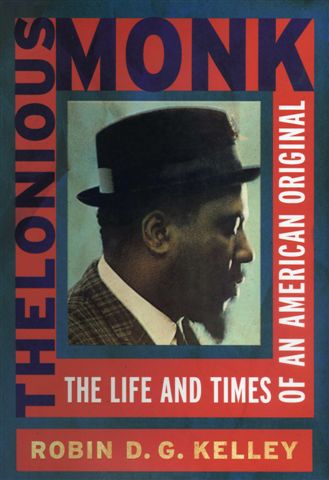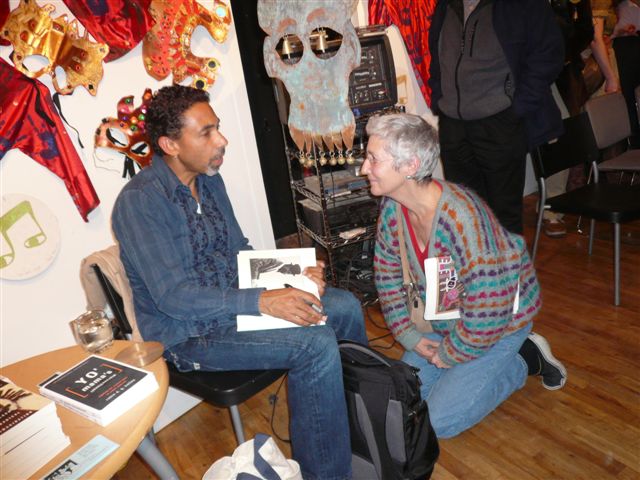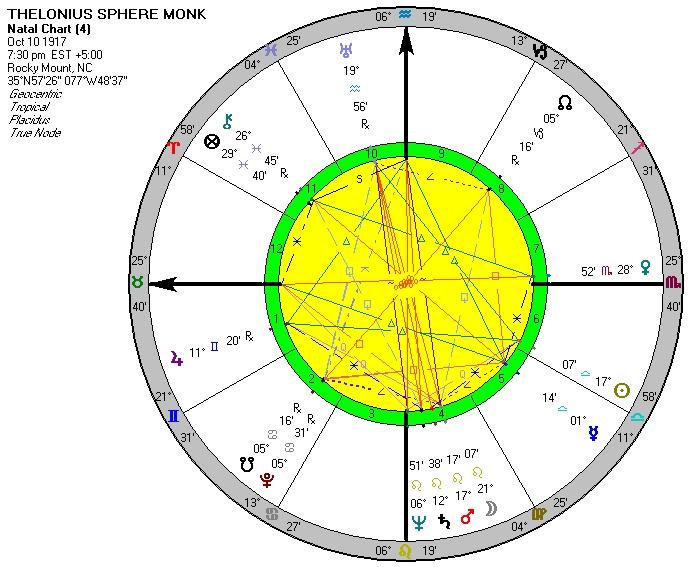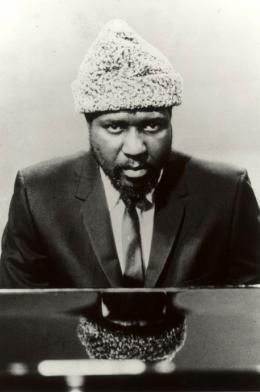Historian and musician Robin D. G. Kelly says that Thelonious Sphere Monk, one of the most innovative pianists and composers ever, was a family man, and that his story is essentially a love story, of the love he had for his family, his wife, and friends.
|
INSIGHTS ON MONK YOU CAN TRUST

At his Book signing, Robin Kelly asked that his account of Monk be read in the slow tempo that Monk played most of his music in.
|
|
|
In this well-researched book Kelly meticulously reconstructs the historical background of Monk's early years by tracing his genealogy back to his slave ancestors as far as 1797, through to his late teens, and by searching New York City housing records and piecing together the history of the black
community of San Juan Hill, the New York City neighborhood where Monk grew up. For me, one of the book’s surprises is selections from a newspaper, The Batavia, describing Monk as a five year old going to the country through the Fresh Air Fund, a New York City project that
sends low-income city children to rural upstate New York for two weeks. According to the article, among other things, the firemen adored young "Philonious" and took him in for those two weeks,
where he could ring the fire truck bell; a rare public account of a historical figure at such a young age In his adult years, Kelly uses interviews from family, musicians, managers and friends in this same way, thereby giving
a perspective and feel of Monk’s personal world. This is what a biography should do, but this has not always been done for Monk.
Thelonious Monk the Life and Times of an American Original creates a portrait of the private Monk. A good portion of the many photos selected by Kelly are of family members and even a photo of the legendary Ruby (“Ruby My Dear”) Richardson.
A more complete picture is rendered of his wife Nellie than has been given elsewhere. We see her as an individual who was his manager, wife and best friend. We understand that there was also a friendship
between Monk, Nellie, and the Baroness Pannonica de Koenigswarter, or Nica. Many speculate that Nica, the baroness and Monk had an affair, or that he left Nellie to live with her in the last decade of his life. Kelly shows this was not the case; that Monk’s health, and Nellie’s
growing work in juice therapies that involved many people taking classes, and making juices in their apartment was too much for Monk, when his health required that he needed rest. Throughout the time that Monk was at Nica’s, Nellie was often there.
Kelly presents Monk as an innovative composer and musician who didn’t stray too far from the melody, and that the minimalist notes that he played were drawn from the complex profundity of his musical vision. Likewise, Kelly pared the complexity of Monk’s story from interviews with him, musicians, managers, family members
and close friends into Monk’s singular voice. And that voice repudiates the misconceptions that have persisted through the years, such as Monk’s genius which was supposedly child-like pure talent, which ignores the musicianship that was developed from his careful and sustained study of music.
Kelly cites how Monk’s generosity towards young musicians whose talent he believed in bordered on self-sacrifice. For example, Bud Powell who was an early protégé; at his gigs Monk would insist that people listen to Powell, even when his audience demanded otherwise - Monk would then give the piano to Powell. Eventually Powell received recognition that could have gone to Monk.
His early musical education ranged from the fundamentals to complex theory, and for that we must thank his mother, Barbara Bats Monk, daughter of Speer Bats, a popular local violinist. Barbara Monk decided that she didn’t want to raise her three children in racist, backward, North Carolina, and when young Thelonious was 5, she
brought them to New York City, and sought out music teachers and enrolled him in some of the best public schools until high school, when he left school to be a musician.
|
Robin Kelly at his book Signing
At The Brecht Forum, New York City

|
|
Kelly with friend Abby London and details of Amir Bey's Mask Parade installation in the background, October 8, 2009
It was clear from Kelly’s presentation at the Brecht Forum in New York City that he was motivated by a deep and exuberant love for Monk that led him on a mission to devote over 10 years to this important biography; yet his love did not interfere with his objectivity.
He gives an in-depth recounting of Monk’s bi-polar episodes, his frequent hospitalizations, and the affects that the stresses of his work and lifestyle had on his health. It is interesting that his father, Thelonious Monk (the Sphere was added to Monk’s name at birth to commemorate his maternal grandfather, Speer Bats) was also bi-polar
and a pianist who, during his bi-polar episodes would break into people’s houses to play piano. He points out the reasons for Monk’s eventual retreat from performing, which were not all health related: from fatigue of critics, the agendas of demanding yet unsympathetic record companies, and unappreciative audiences. During a
period when he was hospitalized, it was clear that Atlantic Records was more concerned with Monk’s contractual obligations to make a quota of albums than even sending him a get well card. What if they were more enlightened – what if they had helped to create an environment that was conducive to his mental and creative well-being, instead of adding to the pressures that he was under?
Finally this book is a document for those interested in the creative process of Thelonious Sphere Monk and the creative process in general, how he rehearsed – often onstage – and to his contribution to the formation of music, not only to be-bop, but his direct influence on Sonny Rollins, John Coltrane, and Bud Powell, Charlie Rouse, among so many others, which in turn influenced future generations of musicians,
and the book’s copious notes and appendixes are indispensible for any serious student of modern musical history.
MONK’S ASTROLOGY
THELONIOUS MONK THE LIFE AND TIMES OF AN AMERICAN ORIGINAL also aids an astrological study of Monk, with the extensive chronology of precise dates and times for important events in his life that it provides.

|
|
Some key points: a Stellium of four planets - Neptune, Saturn, Mars and especially the Moon in Leo in the 4th House, the house of family in the sign of children, Leo. Uranus the innovative planet in his
10 House of career, opposing his Moon/Mars midpoint, which indicates artistic and social nonconformity. Venus, the planet of the arts, and social relations, is the chart's and his Sun's ruler, is in his 7th House in the sign of its Fall, Scorpio,
is quite pronounced, and adding the strong flavor with the innovation of his Aquarius Uranus and Midheaven, suggest remarkable tastes and social orientation. With these planetary and sign combinations of Mars, Saturn, Uranus, in Leo, Taurus, and
the Fixed signs in general, the individual and combined charts of The Art Ensemble of Chicago are recalled. What those combinations give and are shared by them is innovation of the status quo and enduring expressions of new values.
Please visit The Holler's! July 21, 2009 article on The Art Ensemble's astrology. |
The time that Thelonious Sphere Monk was born was given by Kelly as evening, October 10, 1917 in Rocky Mount, North Carolina. While evening is a general term, it helps to place his likely time of birth. “Evening” was an approximation made by a family member I suppose. It suggests to me a time earlier than 9 PM, which could be considered as “night”; and later than dusk. Since the Sun set at 5:38'39" PM, there on that day,
it was probably past “dusk” by 6:30. The Ascendant at that time was 6 degrees 04' Taurus, and the Midheaven at 21 Capricorn 55. The Ascendant changed to Gemini just before 7:45. That would give a chart ruler of either Venus in 28 degrees Scorpio 52 minutes in the 7th House for the Taurus Ascendant or Mercury in 1 degree Libra 15 minutes or later in the 5th House for the Gemini Ascendant. While both planets as rulers can figure prominently for a musician, Venus in Scorpio, in the sign of its fall,
and at home in the 7th House, describes the early difficulties he had with writers and audiences to understand him and his music. Mercury in Libra would have given him an easier time for his acceptance, but maybe emphasized something more easygoing in his personality. By ruling out a Gemini Ascendant, we have a smaller window of time to consider for his birth.
Another factor for determining his birth time is an elevated and retrograde Uranus in its own sign, Aquarius, which is opposite a stellium in Leo, and closely opposing the Moon/Mars midpoint. This would describe his innovative instincts and a natural dissonance, both musically and socially, especially when the nature of his Venus is considered. If a chart is done for 7:30 PM, it will show an Ascendant of 25 Taurus 40', with a Midheaven of 6 Aquarius 19'. Here is one more time window to consider.
Did Thelonious Monk have his Midheaven, the point that symbolizes career and attainment in Capricorn or Aquarius? Either way, he would have had plenty of uniqueness bestowed upon him by the Uranus/Mars/Moon configuration yet his blending of musical traditions in an innovative way could suggest having a Capricorn Midheaven with Uranus in Aquarius in the 10th House. The latest time for a Capricorn Midheaven would be 7:03’56” PM, after which it entered Aquarius.
Looking at important dates that Kelly lists; I tend to favor the later degrees of Taurus Ascendant than an earlier time because it figures in with critical events in his life. Using the 7:30 PM chart, his mother’s move of him, his sister and brother to New York from Rocky Mount, North Carolina shows the Midheaven/Nadir axis conjoining his natal Saturn, which would be consistent with leaving home and separating from his father. A Capricorn Midheaven does not offer an aspect that signifies then.
The birth of his son, Thelonious Sphere Monk Jr. (12/27/49, 7:06 PM, New York City; this is also Monk’s wife’s birthday, 12/27, both their Suns conjoining his North Node), shows important contacts with his progressed Moon and natal and progressed Uranus; progressed Venus opposite progressed Pluto, with both conjoining the natal nodes within minutes; the natal chart’s ruler Venus within minutes of exact conjunction with its ruler Pluto, which exactly conjoins the natal Node. The actual birth time may
be a minute or two before or after, but other events point to the late degree Taurus Ascendant. Although the Angles are the most important houses for rectification, the Progressed New Moon that occurred at his death conjoining his natal 8th House using a Placidus House system is significant. I realize many astrologers prefer other house systems than the Placidus house system, and I think more work can be done if someone wants to search for a more precise time for Thelonious Sphere Monk’s chart.
|
|

THELONIOUS SPHERE MONK AT THE HELM
Here's a video of Monk's quartet playing
Off Minor , filmed in Baden Baden, Germany, 1963, with Charlie Rouse tenor, John Ore, bass, and Frankie Dunlop, drums.
|
|
|
|
|
|